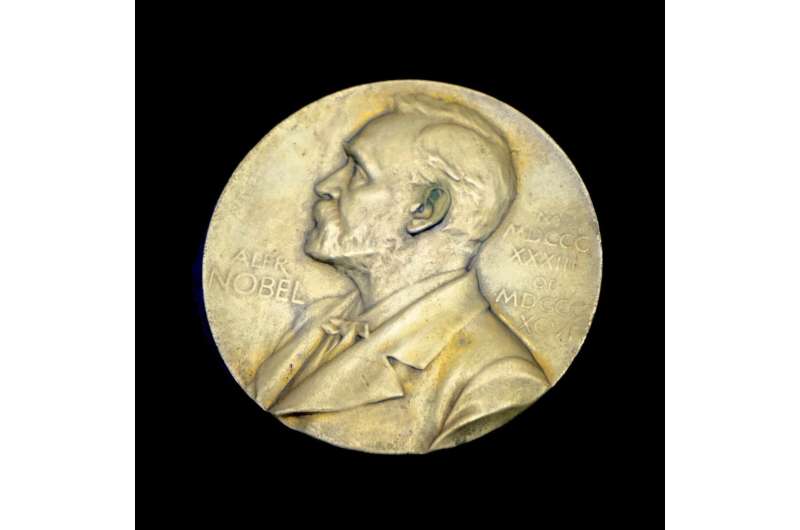Credit: Pixabay/CC0 Public Domain
Are scientists who win Nobel Prizes different in key ways from their peer researchers? What happens to the quality of a scientist's work after they win a Nobel Prize?
Researchers at Northwestern University's Kellogg School of Management sought to answer these and similar questions about the "scientific elite," or those who win prestigious recognition in their fields of study.
They built unprecedented datasets to study the careers of nearly all Nobel laureates in physics, chemistry and physiology/medicine over the past 100 years, comparing these to the careers of less-decorated peers. Key findings emerged, including that Nobel prizewinners produce high-impact work from the outset of their careers, but their pre-prize trajectories look similar to those of peer scientists who don't receive such recognition. Moreover, the prizewinners tend to demonstrate a measurable but temporary decline in the impact of their work after the win, with a quick subsequent bounce back.
"On one hand, we find Nobel laureates and ordinary scientists share remarkably similar career patterns," lead author Jichao Li said. "But we also uncovered notable, previously unknown variations in the careers of those who win the Nobel Prize."
The study, "Scientific Elite Revisited: Patterns of Productivity, Collaboration, Authorship and Impact," was published in the Journal of the Royal Society Interface. It's one of just a handful of empirical attempts to analyze research careers at such a comprehensive level.
Methodology and findings
The researchers focused on the Nobel Prize because it is regarded as science's most prestigious prize. While other studies have examined the prize-winning works alone, the team wanted to research the full careers of laureates to understand bigger-picture patterns.
They used information from official Nobel Prize websites, Wikipedia, Microsoft-provided publication and citation records and other sources to build a dataset covering the career histories of nearly every Nobel laureate in physics, chemistry and physiology/medicine from 1900 to 2016. For comparison, they also created a dataset of more "ordinary" research careers based on Google Scholar and other sources.
The first question the researchers examined was about early performance: is there any early signal that distinguishes eventual Nobel laureates from peers? Their findings suggested that laureates published twice as many early papers as peers and had a rate of "hit papers" (top 1% of 10-year citations) more than six times that of others.
As far as the timing of high-impact work, the important works in Nobel careers tended to follow the "random impact rule" and "hot streak" pattern established by earlier research: they could occur at any time in the scientist's career but tended to be clustered together.
That pattern of timing is similar to that observed for non-prizewinning research careers. But Nobel laureates are more likely than less-decorated peers to have more than one hot streak (1.93 streaks, on average) and to have longer-lasting streaks: 5.2 years versus 3.7 years for ordinary scientists. Nearly 90% of Nobel-winning works occurred within a scientist's hot streak.
"Our results make us confident to say that these elite scientists distinguish themselves from others by producing more early, high-impact work and are more likely to 'hit it big' in the form of multiple clusters of impactful work in their lifetimes," co-author Yian Yin said.
What happens after the Nobel Prize?
Contrary to the widely held belief that "winning begets winning," the research found that laureates produced papers with lower average impact in the two years following the prize than in the period just before the win. In the year immediately after, impact dropped by 11.1% on average, compared to the year before. But by the fourth year, the impact level returned to a level similar to that of the Nobel Prize year. The "Nobel dip" was most obvious for physics laureates, who saw an 18.1% reduction in impact. There was no change in productivity following winning the prize.
The finding of a dip suggests that the scientific community judges work on its own merit, rather than on the researcher's status. What might explain the dip is a further finding that prizewinners were more likely than expected to change research topics post-win, generally moving toward less popular areas. As the researchers write, however, while the "dip-bounce-back dynamics and topic-shifting behavior both occur around the same time (when awarded the Nobel Prize), it does not imply that the two are causally related."
Overall, then, the unique research suggests that while the careers of Nobel winners and peers seem to follow patterns of random impact and hot streaks, laureates produce more and higher-impact papers than peers early in their careers, and are more likely to have multiple hot streaks. While prizewinners experience a post-Nobel dip in impact, this is short-lived.
"Our results offer a new empirical basis for a better understanding of the reliable hallmarks of exceptional careers in science, hopefully inspiring future research in this important area," said Dashun Wang, corresponding author and associate professor of management and organizations at Kellogg.
All three Northwestern researchers involved in the study are part of the University's Center for the Science of Science and Innovation, which is dedicated to understanding the conditions that lead to scientific success and failure.
More information: Jichao Li et al. Scientific elite revisited: patterns of productivity, collaboration, authorship and impact, Journal of The Royal Society Interface (2020). DOI: 10.1098/rsif.2020.0135
Journal information: Journal of the Royal Society Interface
Provided by Northwestern University






















